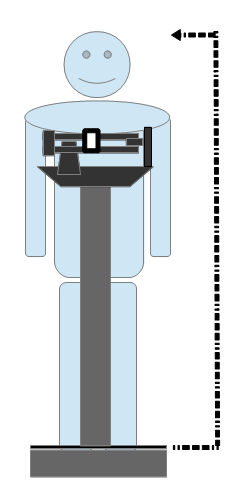The Body Surface Area Calculator contains all  Height and Weightof the major formulas for determining a person's body surface area (BSA) using different units (centimeters, feet or inches and kilograms or pounds). It includes the Mosteller, DuBois, Haycock, Gehan and George, Boyd, Fujimoto,Takahira, Schlich, Wang and Hihara and Costeff equations. It also includes the average (numeric mean) BSA for different demographics including neonatal (newborn), children of age 2, 9, and 10, children in the 12 to 13 year old range, and the mean BSA for men and women.
Height and Weightof the major formulas for determining a person's body surface area (BSA) using different units (centimeters, feet or inches and kilograms or pounds). It includes the Mosteller, DuBois, Haycock, Gehan and George, Boyd, Fujimoto,Takahira, Schlich, Wang and Hihara and Costeff equations. It also includes the average (numeric mean) BSA for different demographics including neonatal (newborn), children of age 2, 9, and 10, children in the 12 to 13 year old range, and the mean BSA for men and women.
The Science
In physiology and medicine, the body surface area (BSA)1 is the measured or calculated surface area of a human body. For many clinical purposes BSA is a better indicator of metabolic mass than body weight because it is less affected by abnormal adipose mass. Estimation of BSA is simpler than many measures of volume.
Equations
| METHODS | Height | Weight | Gender |
| Mosteller | x | x | |
| Gehan and George | x | x | |
| Boyd | x | x | |
| DuBois | x | x | |
| Haycock | x | x | |
| Fujimoto | x | x | |
| Takahira | x | x | |
| Schlick | x | x | x |
| Costeff | x | ||
| Wang Hihara | x | x |
This calculator includes numerous equations that provide estimates for the body surface area. Each equation requires some combination of height, weight, and gender. The table to the right shows which methods employ which combinations of height (H), weight (W) and Gender.
The equations also include a Unified BSA formula by Wang and Hihara for the body surface area of humans and animals based on volume and length.
The BSA Compare formula lets you enter a body surface area and choose a demographic mean for comparison. In this way, you can compare an actual BSA from a patient to their demographic mean which may effect dosage. (See Demographic Means below).
Demographic Means
The mean (average) body surface areas for different demographics are listed below.
- 0.25 m²- Neonate
- 0.5 m² - 2 Year Old Child
- 1.07 m² - 9 Year Old Child
- 1.14 m² - 10 Year Old Child
- 1.33 m² - 12 to 13 Year Old Child
- 1.6 m² - Woman
- 1.9 m² - Man
BSA Applications
- The BSA Compare function lets you enter a body surface area and choose a demographic (above) to compute the percent compared to the mean.
- Wallace Rule of Nines: This computes a percentage of the human body for burn victims based on percentages allocated to different bady parts.
- Rule of Fives: This computes a percentage of the human body for obese burn victims.
- Parkland Replacement Fluid: This compute the volume of replacement fluids needed in the first 24 hours based on the patients weight (mass) and the percent of their body that has been burned.
- BSA Percent: This computes a body surface area based on the total body surface area and a percent..
Usage in Medicine
There have been several important critiques of the use of BSA in determining the dosage of medications with a narrow therapeutic index2, such as chemotherapy. Typically there is a 4–10 fold variation in drug clearance between individuals due to differing the activity of drug elimination processes related to genetic and environmental factors. This can lead to significant overdosing and even more perniciously to underdosing (and increased risk of disease recurrence). It is also thought to be a distorting factor in Phase I and II trials that may result in potentially helpful medications being prematurely rejected.3 The trend to personalized medicine is one approach to counter this weakness.
- Renal clearance4 is usually divided by the BSA to gain an appreciation of the true required glomerular filtration rate(GFR).
- The Quetelet index5 uses a somewhat modified form of the BSA.
- The cardiac index6 is a measure of cardiac output divided by the BSA, giving a better approximation of the required cardiac output.
- Chemotherapy7 is often dosed according to the patient's BSA.
- Glucocorticoid8 dosing is also expressed in terms of BSA for calculating maintenance doses or to compare high dose use with maintenance requirement.
See Also
- Body Mass Index equation and wiki page
External Documents
- ^ http://en.wikipedia.org/wiki/Body_surface_area
- ^ http://en.wikipedia.org/wiki/Therapeutic_index
- ^ http://www.nature.com/bjc/journal/v86/n8/full/6600139a.html
- ^ http://en.wikipedia.org/wiki/Renal_function
- ^ http://en.wikipedia.org/wiki/Quetelet_index
- ^ http://en.wikipedia.org/wiki/Cardiac_index
- ^ http://en.wikipedia.org/wiki/Chemotherapy
- ^ http://en.wikipedia.org/wiki/Glucocorticoid